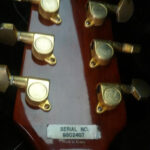Hello! You’ve discovered the quickest and most effective way to tune your guitar. This free online guitar tuner utilizes your device’s microphone to ensure accurate tuning for both acoustic and electric guitars.
Standard Guitar String Notes
Here are the standard notes for each guitar string, starting from the thinnest (1st string) to the thickest (6th string):
- 1st String – E4 (High E)
- 2nd String – B3
- 3rd String – G3
- 4th String – D3
- 5th String – A2
- 6th String – E2 (Low E)
How to Use the Online Guitar Tuner
To begin tuning your guitar with this online tool, simply click the “Turn on” button located beneath the tuner display. Your device will then request permission to access your microphone – please allow this by clicking “Allow” when prompted. This allows the online guitar tuner to clearly hear the sound of your guitar strings.
Now, play each string individually. The chromatic guitar tuner will detect the note you are playing and indicate its accuracy. If the tuner shows that the note is sharp or flat (indicated by a deflection from the center), adjust the tuning peg for that string to tighten or loosen it, respectively. Continue to adjust the tuning peg until the note displayed on the tuner turns green. A green indicator means the string is perfectly in tune 
Repeat this process for all six strings, tuning them to the standard notes listed above.
It’s important to remember that guitar tuning is an iterative process. After tuning all strings from the first to the sixth (or vice versa), we recommend going back and checking them again in reverse order. This is because adjusting the tension of one string can slightly affect the overall tension on the guitar neck and consequently impact the tuning of previously tuned strings. For example, tuning the thinnest string first when other strings are significantly out of tune might require further adjustment after the thicker strings are brought up to pitch.
Explore Alternate Guitar Tunings
Achieving Optimal Guitar Tuning Quality
This online guitar tuner analyzes the frequency of the sound your guitar produces, enabling precise tuning for each string. However, the quality of the tuning can be influenced by factors such as the frequency response of your device’s microphone and any background noise present in your environment. For situations where microphone issues might arise, or as an alternative tuning method, we provide audio samples of each string’s correct pitch for tuning by ear 
How Often Should You Tune Your Guitar?
Regular guitar tuning is essential for maintaining optimal sound quality. Consistent playing, fluctuations in ambient temperature, changes in humidity, and even periods of storage can all cause your guitar to fall out of tune. Generally, even just one hour of continuous playing can necessitate minor tuning adjustments. Furthermore, if your guitar hasn’t been tuned for more than a week, even with minimal playing, it will likely require tuning before you play again.


